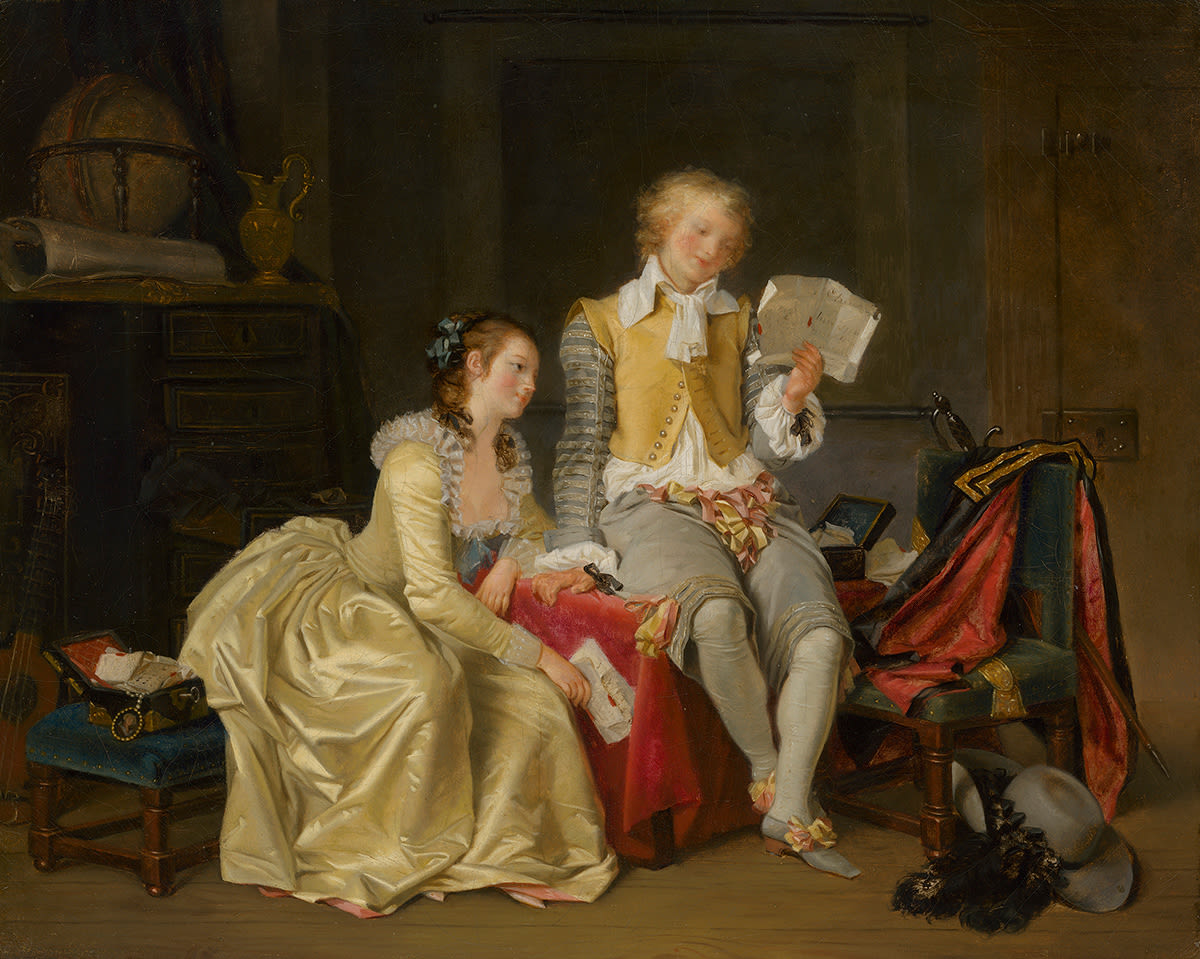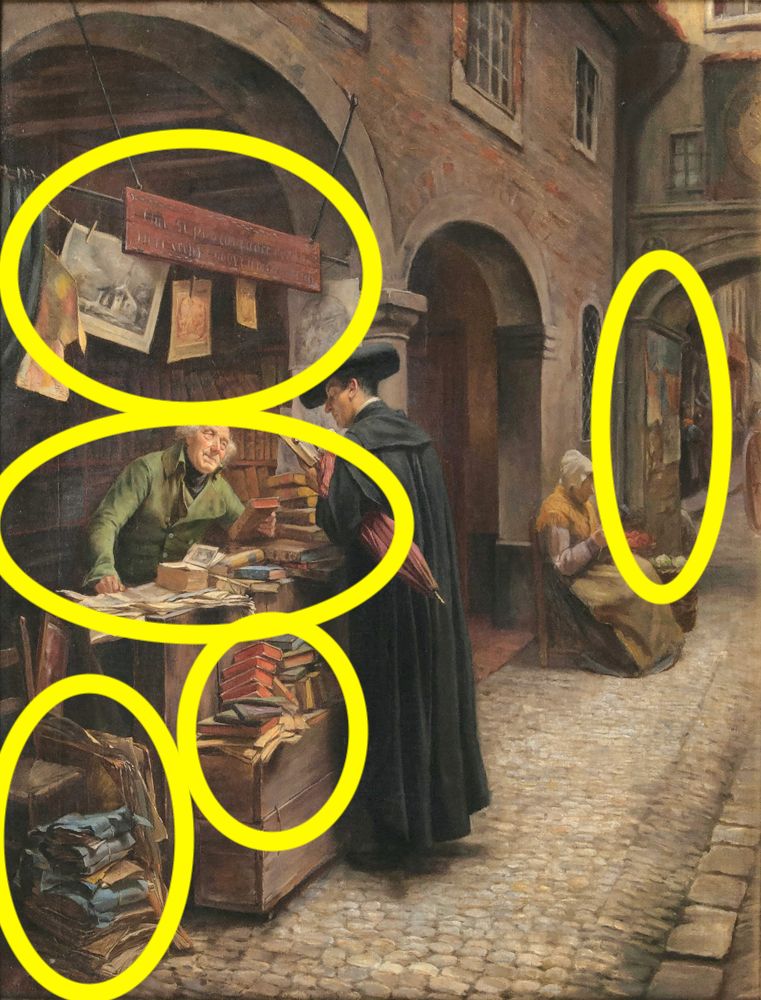
inactive account. Historian currently @uni__augsburg | Co-editor https://t.co/cSJmfBYlxV | Mastodon: @dbellingradt@historians.social | Vertrauensdozent @boeckler_de
How to get URL link on X (Twitter) App


 The street seller is a detail of a painting from Joos de Momper the Younger, a Flemish painter active in Antwerp between the late 16th century and the early 17th century. So the paper crowns were likely sold in Antwerp or nearby.
The street seller is a detail of a painting from Joos de Momper the Younger, a Flemish painter active in Antwerp between the late 16th century and the early 17th century. So the paper crowns were likely sold in Antwerp or nearby. 



 More information on the small print (an etching!) with the letter receiving or sending young woman can be found here:
More information on the small print (an etching!) with the letter receiving or sending young woman can be found here: 

 Let's start the look at rereading (and paper storing) practices of rich Europeans with details on the painting used. You see Marguerite Gérard's painting from c. 1785, nowadays in the Bayerische Staatsgemäldesammlungen - Neue Pinakothek München, sammlung.pinakothek.de/de/artwork/ApL…
Let's start the look at rereading (and paper storing) practices of rich Europeans with details on the painting used. You see Marguerite Gérard's painting from c. 1785, nowadays in the Bayerische Staatsgemäldesammlungen - Neue Pinakothek München, sammlung.pinakothek.de/de/artwork/ApL…


 The selection and combination of three extraordinary topics was an easy task for an experienced publisher. To start with, you needed to buy and read other pamphlets or news prints of the time. Media echoes of interesting stoiries were omnipresent and easy to spot. Have a look:
The selection and combination of three extraordinary topics was an easy task for an experienced publisher. To start with, you needed to buy and read other pamphlets or news prints of the time. Media echoes of interesting stoiries were omnipresent and easy to spot. Have a look:


 The painting came in three versions and the one remaining copy is nowadays in the Neue Pinakothek (Munich: pinakothek.de/kunst/meisterw…). Let's focus on the paper used and present in this imagined scene of a poor poet in his attic room in the 1830s.
The painting came in three versions and the one remaining copy is nowadays in the Neue Pinakothek (Munich: pinakothek.de/kunst/meisterw…). Let's focus on the paper used and present in this imagined scene of a poor poet in his attic room in the 1830s. 

https://twitter.com/PP_Rubens/status/1447237327999340545

 Managing information became a paper business in Early Modern Europe. The expanding administration practices made secretaries, lawyer's offices, tax offices, etc. And they ran on paper, had to store paper, and deal with paper. It was a paper world.
Managing information became a paper business in Early Modern Europe. The expanding administration practices made secretaries, lawyer's offices, tax offices, etc. And they ran on paper, had to store paper, and deal with paper. It was a paper world.https://twitter.com/dbellingradt/status/1376864597534199813?s=20


 The painter of this stunning art work, Gerrit Dou, is considered a master painter of the seventeenth century, so please enjoy the images of the thread. Dou painted this piece of art at age twenty-four, in 1637.
The painter of this stunning art work, Gerrit Dou, is considered a master painter of the seventeenth century, so please enjoy the images of the thread. Dou painted this piece of art at age twenty-four, in 1637. 


 The painting is titled Léon Pallière (1787–1820) in His Room at the Villa Medici, Rome, and was painted in 1817 on oil. The artist: the French Jean Alaux.
The painting is titled Léon Pallière (1787–1820) in His Room at the Villa Medici, Rome, and was painted in 1817 on oil. The artist: the French Jean Alaux. 

 As I have highlighted in earlier threads like this one (
As I have highlighted in earlier threads like this one (https://twitter.com/dbellingradt/status/1326477938171195393), paper was from the fourteenth century onwards increasingly being used for more and more communication flows. Hello inky paper states and letter writing humans, here comes the printing industry.

 Notaries needed offices in early modern Europe, because they provided paper businesses: they used papers as a general service. In fact, producing evidence in a lawsauit is a paper practice. First things first: writing on paper on a regular basis is the main office work.
Notaries needed offices in early modern Europe, because they provided paper businesses: they used papers as a general service. In fact, producing evidence in a lawsauit is a paper practice. First things first: writing on paper on a regular basis is the main office work.

 Whenever the general conflict and their military campaigns heated up in the seventeenth-century, media flows about Ottomans ("Türcken") found their way into print in Christian Europe. Broadsides and pamphlets, even a German newspaper devoted to the topic was published these days.
Whenever the general conflict and their military campaigns heated up in the seventeenth-century, media flows about Ottomans ("Türcken") found their way into print in Christian Europe. Broadsides and pamphlets, even a German newspaper devoted to the topic was published these days.

 Let's start with this instrument, almost hidden, but important for paper usages: the quill. More precisely: the feather quill, often a goose feather prepared for writing. Nota bene: the word 'pen' derives from penna, Latin for feather. No quill, no fun at the secretary.
Let's start with this instrument, almost hidden, but important for paper usages: the quill. More precisely: the feather quill, often a goose feather prepared for writing. Nota bene: the word 'pen' derives from penna, Latin for feather. No quill, no fun at the secretary.

 Sorry, the what?
Sorry, the what? 

 Frühe Zeitungen seit dem 16. und 17. Jahrhundert enthielten viele Fremdwörter und Fachtermini, weil die Inhalte (Neuigkeiten, auch "Zeytungen" genannt) großteils aus "Avisen" stammten - aus brieflichen Meldungen verfasst von gebildeten Spezialisten.
Frühe Zeitungen seit dem 16. und 17. Jahrhundert enthielten viele Fremdwörter und Fachtermini, weil die Inhalte (Neuigkeiten, auch "Zeytungen" genannt) großteils aus "Avisen" stammten - aus brieflichen Meldungen verfasst von gebildeten Spezialisten. 
 Let's focus on the details.
Let's focus on the details. 


 I am curious to learn if the non-Western book cultures invented the bookworm (or similar small animals eating books or paper/parchment etc.) as well? #globalbookhistory to the rescue. Thanks for spreading the word.
I am curious to learn if the non-Western book cultures invented the bookworm (or similar small animals eating books or paper/parchment etc.) as well? #globalbookhistory to the rescue. Thanks for spreading the word.


 To start with, what is imagined in the painting is a streetselling scene in a nineteenth century urban context. The painting is called "Beim Antiquar", and so we are looking at a second hand trade of an antiquarian. The nineteenth century saw the rise of this trade.
To start with, what is imagined in the painting is a streetselling scene in a nineteenth century urban context. The painting is called "Beim Antiquar", and so we are looking at a second hand trade of an antiquarian. The nineteenth century saw the rise of this trade.

https://twitter.com/RembrandtsRoom/status/1326116633086189569
 Let's start with the obvious: people are writing in this painting and in general. The material they are writing on - paper sheets, bound blank books, etc. It is paper letters (and paper envelopes), paper pages in accounting books, in writing books. All on paper.
Let's start with the obvious: people are writing in this painting and in general. The material they are writing on - paper sheets, bound blank books, etc. It is paper letters (and paper envelopes), paper pages in accounting books, in writing books. All on paper.